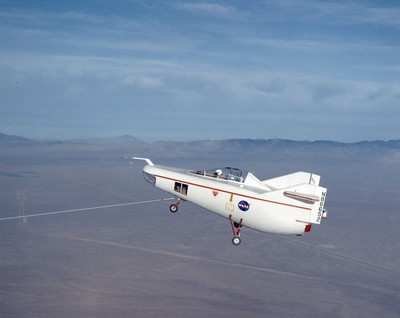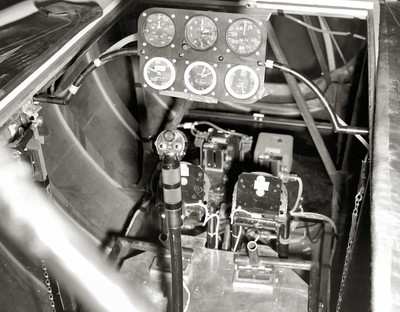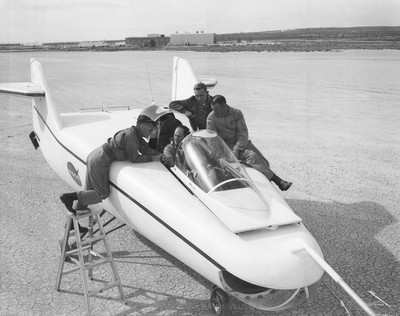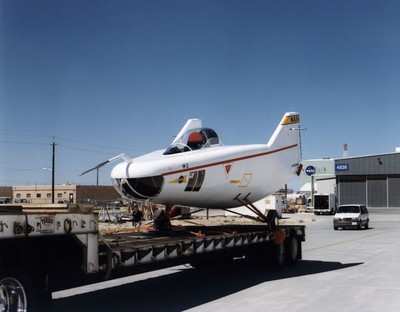'Look Ma! No Wings!'
The planned retirement of the space shuttle fleet in 2010 will
bring to a close an era that opened in the Antelope Valley nearly a
half century ago. The vehicle which began that era – the
M2-F1 – was an unlikely forefather to the shuttle. The
world’s first manned lifting body, the M2-F1 was made of
wood, had an internal framework of steel tubes, looked like a
bathtub sitting on a tricycle, and had no wings.

Conceived by NASA engineers at the Ames Research Center, the
lifting body was intended as an alternative to a capsule
spacecraft, which returned to Earth dangling under a parachute. A
lifting body was not a conventional winged aircraft, but rather,
used air flowing over its fuselage to generate lift. This design
allowed it to renter the atmosphere and land on a runway like a
conventional airplane.

The idea of an aircraft without wings met with skepticism among
engineers. R. Dale Reed of the NASA Flight Research Center (now the
Dryden Flight Research Center) was the exception. Reed was excited
about the concept, and began testing a series of small balsa wood
and tissue-paper lifting bodies which he flew down the hallways of
the center's main office building and off its roof.

Reed was successful in raising interest in the concept, and
center director Paul Bikle approved discretionary funding to
construct a "homebuilt" lifting body called the M2-F1 (for
“Manned 2 Flight 1).
Noted sailplane builder Gus Briegleb, who built wooden
high-performance sailplanes at his facility at the El Mirage
Airport some 40 miles from the center, was engaged to build the
fuselage. The internal framework was built in a curtained-off
section of Briegleb's hangar with a sign reading
“Wright’s Bicycle Shop.” Using volunteer help
from center personnel, Reed kept the cost of building the M2-F1 to
about $30,000.

Because the M2-F1 was unpowered, a tow vehicle was required.
Walter “Whitey” Whiteside, a hot-rod enthusiast who
worked at the center, was sent to purchase a new 1963 Pontiac
convertible. Following modification at two race shops, the car was
capable of reaching 110 miles per hour with the M2-F1 in tow.
The first car tow attempts were made on March 1, 1963, with NASA
research pilot Milton O. “Milt” Thompson in the
cockpit. The M2-F1 vehicle bounced back and forth on its main
landing gear, and was unable to lift off the lakebed surface.
Following the poor results, the M2-F1 was taken to the Ames
Research Center outside San Francisco for wind tunnel testing,
which lasted until March 15. The vehicle’s control system was
modified based on the data.

The second attempt to fly came on April 5, 1963. Thompson was
able to lift off and remain airborne for longer periods of time
while the tow car roared across the lakebed. After several flights,
he was able to remain aloft for the whole four miles of the run.
During the spring and summer, Thompson made more car tow flights,
to higher speeds and altitudes.

The first M2-F1 free flight came on August 16, 1963. A C-47
towed the M2-F1 to an altitude of about 5,200 feet above the
lakebed. Thompson released the towline and began a steep descent.
The flight lasted under two minutes, with an average descent rate
of 4,000 feet per minute. The M2-F1 handled well during the brief
flight.
Thompson made several more flights during the summer and fall.
By the time the M2-F1 was retired on August 18, 1966, it had made
77 air tow flights and about 400 car tows.

By this time, the first “heavyweight” lifting body,
the M2-F2, had begun flights, launched from the NB-52 mothership.
The M2-F2's design was similar to the M2-F1, and had similar flight
characteristics during its unpowered phase. This and the subsequent
manned lifting bodies, the HL-10, X-24A, M2-F3, and the X-24B, set
the stage for construction of the space shuttles.
Although in the end the lifting body design was rejected for the
shuttle, the lifting bodies provided extensive data on the
aerodynamics and controllability of a low lift-over-drag unpowered
vehicle that was directly applicable to the design of the
shuttles.

The M2-F1 was restored in the mid-1990s, and returned to NASA
Dryden in August 1997 where it remains on display today. (ANN
Thanks Curtis Peebles, Historian, NASA Dryden Flight Research
Center for the story].
 ANN's Daily Aero-Term (04.20.24): Light Gun
ANN's Daily Aero-Term (04.20.24): Light Gun Aero-News: Quote of the Day (04.20.24)
Aero-News: Quote of the Day (04.20.24) ANN's Daily Aero-Linx (04.21.24)
ANN's Daily Aero-Linx (04.21.24) Aero-News: Quote of the Day (04.21.24)
Aero-News: Quote of the Day (04.21.24) ANN's Daily Aero-Term (04.21.24): Aircraft Conflict
ANN's Daily Aero-Term (04.21.24): Aircraft Conflict










